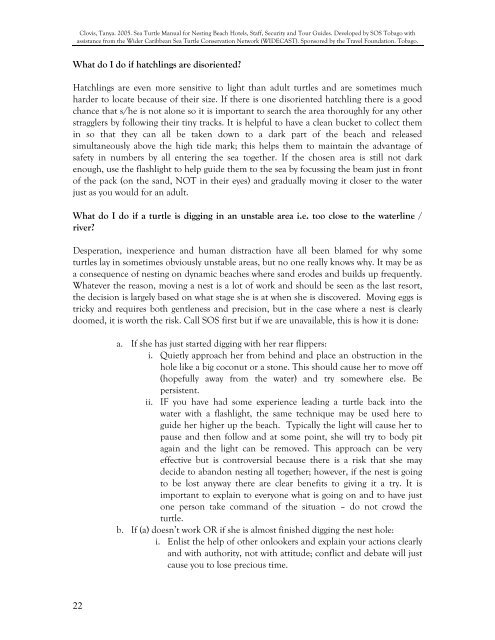Clovis, Tanya. - WIDECAST
Clovis, Tanya. - WIDECAST
Clovis, Tanya. - WIDECAST
Create successful ePaper yourself
Turn your PDF publications into a flip-book with our unique Google optimized e-Paper software.
<strong>Clovis</strong>, <strong>Tanya</strong>. 2005. Sea Turtle Manual for Nesting Beach Hotels, Staff, Security and Tour Guides. Developed by SOS Tobago with<br />
assistance from the Wider Caribbean Sea Turtle Conservation Network (<strong>WIDECAST</strong>). Sponsored by the Travel Foundation. Tobago.<br />
What do I do if hatchlings are disoriented<br />
Hatchlings are even more sensitive to light than adult turtles and are sometimes much<br />
harder to locate because of their size. If there is one disoriented hatchling there is a good<br />
chance that s/he is not alone so it is important to search the area thoroughly for any other<br />
stragglers by following their tiny tracks. It is helpful to have a clean bucket to collect them<br />
in so that they can all be taken down to a dark part of the beach and released<br />
simultaneously above the high tide mark; this helps them to maintain the advantage of<br />
safety in numbers by all entering the sea together. If the chosen area is still not dark<br />
enough, use the flashlight to help guide them to the sea by focussing the beam just in front<br />
of the pack (on the sand, NOT in their eyes) and gradually moving it closer to the water<br />
just as you would for an adult.<br />
What do I do if a turtle is digging in an unstable area i.e. too close to the waterline /<br />
river<br />
Desperation, inexperience and human distraction have all been blamed for why some<br />
turtles lay in sometimes obviously unstable areas, but no one really knows why. It may be as<br />
a consequence of nesting on dynamic beaches where sand erodes and builds up frequently.<br />
Whatever the reason, moving a nest is a lot of work and should be seen as the last resort,<br />
the decision is largely based on what stage she is at when she is discovered. Moving eggs is<br />
tricky and requires both gentleness and precision, but in the case where a nest is clearly<br />
doomed, it is worth the risk. Call SOS first but if we are unavailable, this is how it is done:<br />
a. If she has just started digging with her rear flippers:<br />
i. Quietly approach her from behind and place an obstruction in the<br />
hole like a big coconut or a stone. This should cause her to move off<br />
(hopefully away from the water) and try somewhere else. Be<br />
persistent.<br />
ii. IF you have had some experience leading a turtle back into the<br />
water with a flashlight, the same technique may be used here to<br />
guide her higher up the beach. Typically the light will cause her to<br />
pause and then follow and at some point, she will try to body pit<br />
again and the light can be removed. This approach can be very<br />
effective but is controversial because there is a risk that she may<br />
decide to abandon nesting all together; however, if the nest is going<br />
to be lost anyway there are clear benefits to giving it a try. It is<br />
important to explain to everyone what is going on and to have just<br />
one person take command of the situation – do not crowd the<br />
turtle.<br />
b. If (a) doesn’t work OR if she is almost finished digging the nest hole:<br />
i. Enlist the help of other onlookers and explain your actions clearly<br />
and with authority, not with attitude; conflict and debate will just<br />
cause you to lose precious time.<br />
22
















